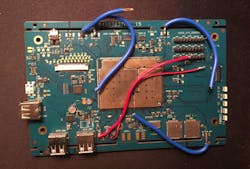Download this article in PDF format.
Baoguo Wei has come up with a module that could hasten the development of medical devices for the IIoT. Starting in March 2015, Phoinix Technologies has helped IoT developers from concept to manufacturing with back end as a service (BaaS), BaaS-enabled internet modules, app development, and manufacturing services. The mobile BaaS technology is built on top of the backend of its tele-medicine and tele-imaging platform. I had a chance to talk to him about his “Blink’r” technology and the overall state of the industry.
What is your background?
My name is Baoguo Wei, and my background includes being part of the early days of the IIoT. Prior to founding Blink’r, I founded a number of companies, including Phoinix Technologies, a mobile-backend as a service provider. I am also the founding member of AgaMatrix, a company that developed the world’s first connected blood-glucose meter, an IoT application in healthcare.
The Blink’r IoT module contains a powerful ARM quad-core A53 microprocessor chip, cellular communication, Wi-Fi and Bluetooth, USB signaling, GPS, and rich peripherals for embedded systems. The module is powered by Android 5.1 with built-in connection to a cloud backend and data visualization.
What is your experience with the Industrial Internet of Things (IIoT)?
I have been working on the IIoT since its inception. I led the team that developed iBGStar, the first iPhone and cloud-enabled blood-glucose meter. In the very early days of IIoT, I developed a bulk goods distribution system that includes fleet management, fuel-tank monitoring, and a cloud-based fuel-delivery path optimization algorithm.
What are some of the problems you see in IIoT?
One issue not being discussed with the IIoT is the long development time needed to get a device from conception to production. There is also the difficulty in finding qualified engineers for each stage. A typical IoT product consists of hardware, embedded software, a cloud backend, and apps. This requires a large team a long time to develop a product. The team needs to define system architecture, protocol of communication among hardware, embedded software, apps and the cloud backend.
Hardware prototypes take time from design and fabrication, to debugging each cycle—and it typically takes a few cycles to get the prototype right. Each time hardware changes, it could affect the app and cloud backend. In design verification, it takes longer to fully verify and validate a complicated system with hardware, embedded software, cloud backend and app, rather than just verify one of those aspects. A medical device, for example, can spend two years in development with a team of 15+ engineers before it moves to FDA review.
How is IIoT affecting the medical industry?
What stymies the medical industry is that in addition to the long development cycles for IIoT, a device has to go through the FDA approval cycle. There could be four years for device conception to FDA approval. People are being deprived of devices due to the lag time. In addition, the long cycles make the environment difficult for entrepreneurs to compete in the market.
A connected medical device development team consists of hardware engineers, embedded software engineers, app engineers, backend engineers, user-interface engineers, mechanic engineers, manufacturing engineers, process engineers, test engineers, quality assurance engineers, and clinic engineers. In a typical connected medical-device development, three basic components need to be developed: hardware, an app, and a cloud backend.
The Blink’r IoT development kit empowers developers in the design, prototype, and building of software and other features onto a combined hardware and software platform.
The development cycle starts with a usability study and feasibility study, and then enters into production definition/risk analysis stage. That is followed by engineering design and development, engineering verification, product validation, pilot production, and manufacturing process validation, and, finally, mass production. Given each step involves a quite large team and many different pieces need to work together, in addition to the typical three- to six-month clinic testing, it takes a long time to move to FDA submission.
How can this new technology help with this lag and other problems?
It helps by having access to technology that allows system designers to design, prototype, and build software as well as other features on to a combined hardware and software platform. A platform like this will need four key features:
1. A cloud backend with data visualization that enables people-to-people, machine-to-machine, and machine-to-people communication.
2. A cloud- and visualization-connected production-ready module with an ARM microprocessor chip, cellular communication, Wi-Fi and Bluetooth, USB signaling, and rich peripherals for embedded systems.
3. Easy-to-use development platform with rich templates to interfacing to physical world and cloud
4. A few development kits with the entire cloud infrastructure built in to empower developers with very limited resources to rapidly build a prototype.
This is what I focused on when developing Blink’r. It should mitigate and reduce these long lead times for medical IIoT devices.
Why Kickstarter?
We believe there is a market need for this product, and Kickstarter allows us to reach a global market quickly that will help bring the toolkit to mass production much faster. The Kickstarter or general crowd-funding platform offers us a fast way to get market feedback of the product in addition to the funding. With a crowd-funding platform, we can interact with customer directly to get feedback to improve our system. For example, we will offer a few different development kits on the crowd-funding platform; we will know which kits or which combination of kits serve the IoT developer better by looking at order data and feedback for our product.



